Version Anglaise
(in english) The Iliad and the Odyssey
The Iliad and the Odyssey
Reminder of the origins of the Iliad and the Odyssey
The Iliad recounts the end of the Trojan War, which was triggered by a news item:
(The musician Offenbach commemorated the event with music).
Helen, wife of Menelaus, the king of Sparta, was kidnapped by Paris, son of Priam, king of Troy; suddenly, Menelaus went to Troy to recover his wife, with the help of the Achaean kings (the current Greeks). The war lasted ten years.
Odysseus, one of the Achaeans, allows the capture of the city thanks to the famous "Trojan Horse", then, the war over, undertakes to return to his homes.
He will be prevented from doing so by the gods for ten years. This wandering is told in the Odyssey.
The study of the Iliad by Schliemann, a German archaeologist, has led to the discovery of the site of Troy.
... Let's take a closer look at the Odyssey of Ulysses
It is not known whether Homer actually existed. But he is credited with writing the poems of the Illiad and the Odyssey, which have previously been sung by the Aèdes for centuries.
Literary interpretation of the Odyssey
According to the literary ones, the Odyssey would have no real basis.
They speak of the fabulation proper to the epic composition. They study the texts to identify "poetically effective" combinations.
"Homer has picked up everywhere", says Pierre Vidal-Naquet (In "Les collections de l'histoire" N° 24, July-September 2004)
Luc Ferry, the philosopher and former minister, speaks of the Odyssey as a "dreamed geography" in the journal Science et Avenir of July/August 2017)
According to them, it would therefore be a totally artificial creation.
L’Odyssée
If we think, unlike the literary ones, that the Odyssey tells more or less a concrete reality, as Schliemann did for the Illiad, it is interesting to try to find the places where the action took place.
(in english) The Hellénist Victor Bérard
Victor Bérard
Victor Bérard, born in 1864, Hellenist, diplomat and politician, devoted his life to finding the sites visited by Ulysses. He made a translation of the Odyssey, and wrote a book entitled "In the wake of Ulysses".
The preconceived ideas of this Hellenist led him to limit his research to the Mediterranean, and his conclusions passed into the collective memory: the Strait of Messina would be the site of Charybdis and Scilla, the country of the Lotophagi would be in Tunisia, the country of the Lestrigons in Corsica in Bonifacio, etc.
He actually found suitable landscapes, more or less consistent with the description made in the Odyssey, inside this sea.
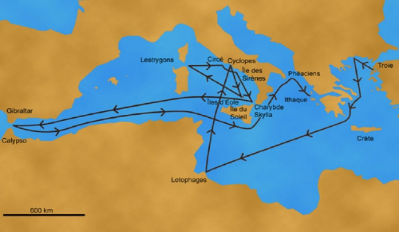
But Victor Bérard did not take into account the indications of time yet inscribed in the text in the same way as the descriptions, which leads, according to his interpretation, to incoherent speeds of movement, or to passages deliberately ignored.
Let's see what is the interpretation of V. Bérard:
From Troy, Odysseus and his companions (12 boats) go to the land of the Kikones (this is present-day Macedonia). They plunder the city and kill the warriors. They are repulsed by warriors from within.
The north wind (Boreas) pushes them to Cape Malea.
From Cape Malée to the land of the Lotophagi.
After passing Cape Malea, the north wind prevented them from sailing up to Ithaca, and a nine-day storm drove the fleet beyond Kythira. On the tenth day, they arrive in the land of the Lotophagi
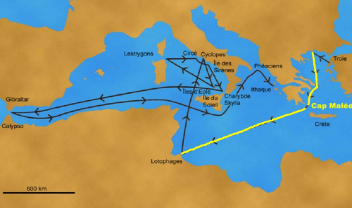
The land of the Lotophagi is assimilated by V. Bérard to Djerba, which is an island, while Ulysses speaks of a continent.
The duration of the announced trip (9 days), and the imagined journey (588 nautical miles, or 1090 km), assumes a daily average of 65.3 miles, ie a speed of 2.7 knots. This seems very little for ships pushed by the storm.
From the land of the Lotophagi to the land of the Cyclops.
Leaving the land of the Lotophagi, they arrive in the "land of round eyes" which are named "The Cyclops". (Cyclops have always been equated with volcanoes.)
In front of this island, says the Odyssey, a "small island": excellent land, watered meadows, soft, suitable for vines and wheat. This island is populated only by goats.
Ulysses, leaving his troop there, goes to the main island with some warriors, visiting "a high cave", lair of a monster with one eye: Polyphemus
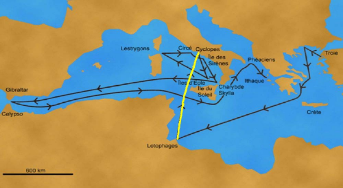
The arrival site (Vesuvius) designated by V. Bérard is not an island. We do not see this small fertile island that is in front (Ischia, cited, does not correspond at all to the description). As for the "land of round eyes", there is only one volcano.
From the land of the cyclops to the island of Aeolus.
After getting rid of Polyphemus, they leave to reach the island of Eole: an island that floats, says the Odyssey, with bronze walls, a polished rock that points to the sky.
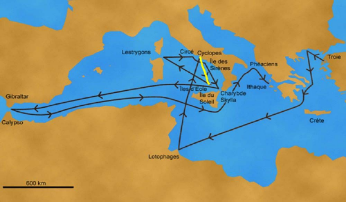
The Aeolian Islands might be fine (maybe because of their name?), but there are 17 of them, which is Eole's abode?
Round trip to Ithaca.
The odyssey says: When they leave, after a month of sojourn in which they were well received by Aeolus, they intend to return to Ithaca.
Aeolus gives Ulysses a bag containing all the winds, to facilitate his journey. But the companions of Odysseus do not know what this otter contains, and are jealous of this gift.
The journey lasts nine days, then the companions of Odysseus open the bag, to see this gift.
The winds are released, and a new storm brings them back to the island of Aeolus.
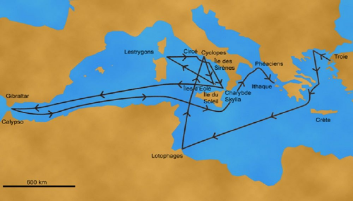
Bérard considers this passage of the text to be a poetic embellishment.
It is true that this trip to Ithaca (nine days announced) would be excessively slow: 1.5 knots
It would impose a passage through the Strait of Messina (Charybdis and Scylla according to him), but the text does not mention it. And the duration of the return – nine days too, pushed by the storm and which would make a hell of a bend to cross the Strait of Messina does not seem well compatible with the locations presented.
It does not fit well, and V. Bérard ignores this episode.
From the island of Eole to the land of the Lestrigons
Aeolus, as a result of what happened to them, thinks them cursed by the Gods, and drives them away.
They leave this island, to sail six days and six nights.
On the seventh day they arrive in the Lestrigon country.
In this country, the nights are short: the shepherd who leaves with his flocks greets another shepherd who returns.
The days are long: a brave man could earn double pay
The port, "well known to sailors", is encased between two cliffs and very elongated.
The Lestrigons are in a bad mood and throw stones at boats.
The fleet is destroyed, only Ulysses' ship escapes
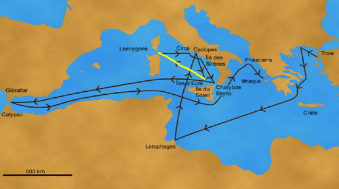
Bérard locates the Lestrigon country in Sardinia or Corsica, by identifying the port described with Bonifaccio. The route described (308 miles) is covered in six days! ... Average 2 knots !... As for the length of the days, even in summer, it would not allow to earn double salary.
The island of Circe.
Ulysses and his remaining companions, leaving the other destroyed boats there, reach the island of Aiaié, home of Circe.
Ulysses encounters a deer ten horns.
From the summit near the anchorage, we see a low plain surrounded by sea on all sides.
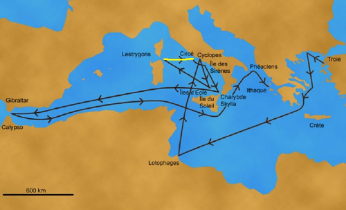
Monte Circeo is not located on an island. V. Berard who chose this site on the basis of his name, defends himself by saying that the marshes present between the mount and the land could have been confused with the sea! For a Ulysses "with a thousand tricks", the confusion is not credible.
Visit to the Underworld, omitted by V. Bérard
When spring returned, Circe told Odysseus to make a trip to the Underworld, to consult the soothsayer Tiresias who was there.
The journey begins with Boreas, the north wind, and continues to the confluence of several rivers of the underworld (the Acheron and the Pyriphlegethon, the Styx and the Cocytus).
Odysseus meets many disappeared, and collects the predictions of the soothsayer Tiresias.
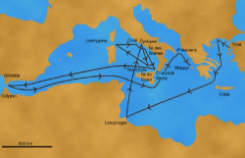
Victor Bérard outright ignores this passage of the Odyssey.
The Sirens, Charybdis and Scylla
Returning from the Underworld to Circe, Ulysses considers the return journey.
Circe warns him against the Mermaids, birds with charming voices.
Then she describes two routes:
1/ The Stones of the Pinnacle, exposed to the ocean. Only the Argo was able to pass these pitfalls.
2/ The two pitfalls of Charybdis (which swallows black water...) and Scylla (which houses a monster.
Victor Bérard proposes the Strait of Messina for the site of Charybdis and Scylla and the island of Ischia to host the sirens.
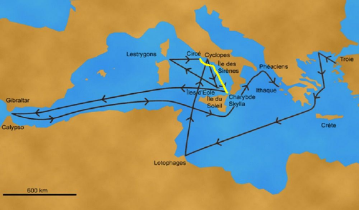
Comments: But we do not see in this stage the route "exposed to the Ocean". And the supposed places are not very much in line with the descriptions.
Trident Island
Past the Sirens, and Charybdis and Scylla, we arrive at the island of Trident called the Odyssey. In fact. the term "trident" is an elegant translation made by V. Berard. The original text speaks of an island with three points: the Trinacrie
There are herds of cows and sheep, which must not be touched (They belong to the Gods)
The boat is blocked by the south winds (Notos), which prevent it from taking to the sea.
The companions of Odysseus, driven by hunger, kill an ox of Apollo.
The Gods are angry and punish offenders: the boat is struck by lightning
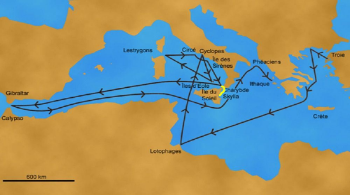
Comments: The "three-pointed island" is understood by Victor Bérard as a "triangular island". But to see it like that, you need a map, and it doesn't seem like you can do that.
On Sicily:
Bérard therefore locates the "island of the trident" in Sicily. This territory is supposed to be distant in the story of the Odyssey. It was in fact very well known to the contemporaries of Ulysses. Odysseus himself, on his return, meets his father Laerte; He tells him a false story to hide his identity.
In this speech, he speaks of a "return from Sicily" (page 871 of the edition of the Pléiade), and further away from a servant – the wife of Dolios, servant of Laerte – under the name of "the old woman of Sicily" (page 873), and he does not speak of Trinacrie.
In fact, Sicily was part of the well-known world of the Achaeans.
Calypso
Struck down by Zeus for killing Apollo's oxen, Odysseus passes the pitfalls of Charybdis and Scylla, and drifts for nine days, clinging to the wreck of the boat.
He arrives on an "ocean island": the land of Calypso
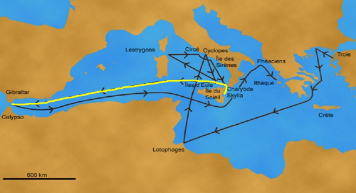
Comments : This drift ending at Gibraltar would cause Ulysses to travel 1074 miles in nine days, which corresponds to a drift speed of 4.97 knots. This is much more than the speeds of other trips, including those pushed by a storm!
Again, the speeds are not credible. As for "The Ocean Island", no trace !!!
The return journey
After a year of stay, the Gods are worried and send Hermes to ask Calypso to free Odysseus.
Odysseus builds a boat, then makes a seventeen-day journey home.
He is alone, all his companions have disappeared.
In fact, he arrives in Scheria, among the Phaeacians.
It is there that he tells his journey to the king of the island Alcinoos, father of Nausicaa.
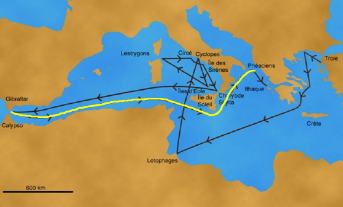
Comments: New inconsistency of speeds: this return trip, which lasts 17 days, is therefore carried out, on a boat, at an average of 3.2 knots. It's slower than the drift, clinging to a wreck, that brought him to Calypso!
The departure from Calypso begins towards the south ("He was looking at the Pleiades", says the text, and this constellation is located towards the south"). The direction of the Pleiades is not that taken in this interpretation.
(in english) Different interpretations & Speed of boats
Different interpretations
Robert Philippe: Agrégé in history, supports the thesis that The Odyssey comes out of the Mediterranean. (N° 22 of the magazine Planète)
Gilbert Pillot: Hellenist, author of the "Secret Code of the Odyssey", imagines and searches for a route outside the Mediterranean.
Alain Bombard the well-known navigator, promoter of the rubber boat, supports the thesis of G. Pilot.
New proposals:
The boats of the Odyssey
What were the characteristics of these boats. The text of the Odyssey gives us some indications:
They are deep-sea cruisers. They can carry 52 rowers (data mentioned in the text of the odyssey). So there are 26 benches.
They are therefore 20 to 30 meters long.
Representations can be seen on ceramics, cups and vases.
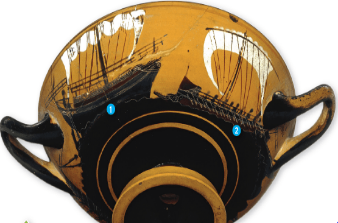
![]()
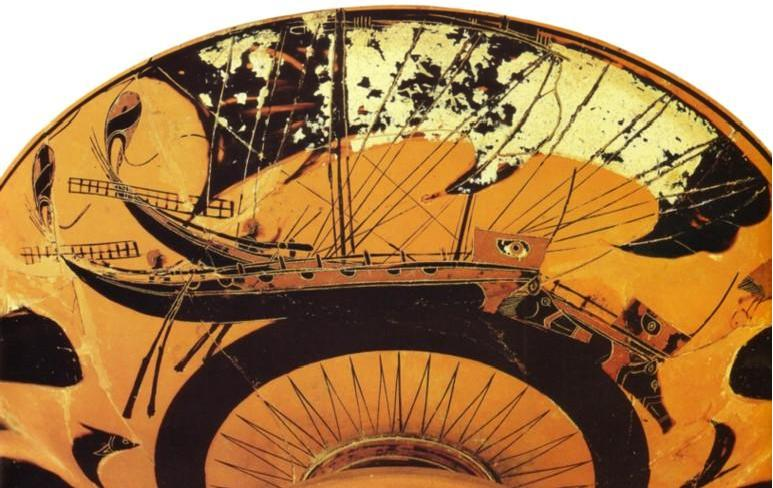
And it was made a reconstruction for the ship of the Argonauts, although with only 10 pairs of oars. Ulysses' boats were longer.
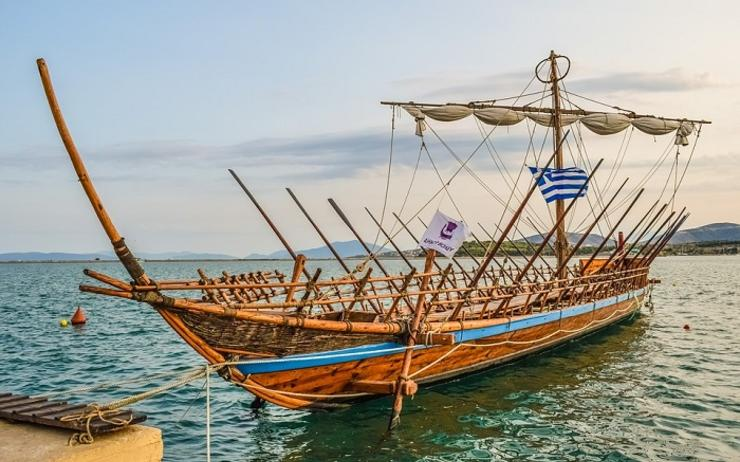
Daily speed and distances
Today, an empirical calculation formula makes it possible to define the maximum possible speed for a boat hull:
Critical velocity (knots) = 2.4 x Square root of waterline length
Either for a 16 m boat: 9.6 knots
Or for 20 m: 10.7 knots
And per 24 hours
at 10 knots the boat is 240 miles (444 Km)
or at 9 knots it is 216 miles
Here is an indication: the ships in question are therefore capable of sailing up to ten knots.
We notice that in the Odyssey the distances are expressed in days of navigation.
What for?
In our motor car civilization, if we ask the question: how long does it take to go, for example, from Avignon to Marseille, the answer will be: about 3/4 hour.
The answer is obvious to everyone, by car; These are supposed to travel at their maximum authorized speed, on the shortest lane, and, depending on the distance, we will respond accordingly.
Similarly among the Greeks, civilization of sailors, a day of navigation, it is with the wind in its sails and the sail that carries, to the maximum of the possible speed of the boats. Let us put 9 knots . And at that speed, you travel 216 nautical miles in 24 hours.
For proof:
Journey of Telemachus
Telemachus, the son of Odysseus, in the hope of having news of his father goes from Ithaca to Pylos the dunes, to go and meet Menelaus, the king of Sparta, who was companion of Odysseus during the Trojan War; There are 73 miles measured on the map, made from four hours after sunset, until dawn, or 8 hours on a night of 12 hours. This corresponds to a speed of 9 knots.
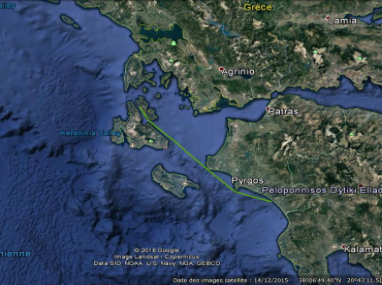
Story of Menelaus
These are only two sentences lost in the entire text of the Odyssey. But they are only understandable by assuming the speed of nine knots.
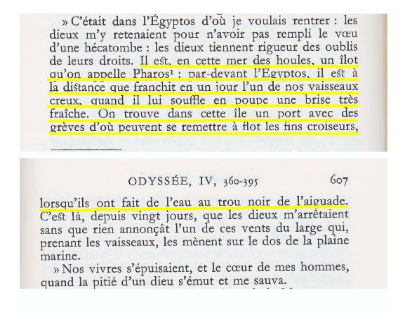
One day (24 hours) at 9 knots is 216 miles; only the island of Cyprus corresponds to this distance: it is 245 miles from Alexandria or 202 miles from Port Said.
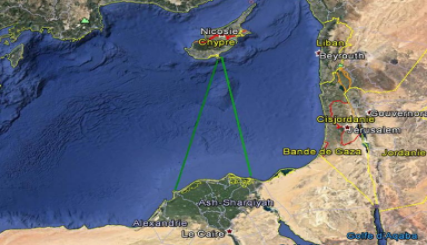
On the map, in the south of Cyprus, we see Nicosia, which nearby has a port, a beach to run aground, a aiguade, as described by Menelaus. …
![]()
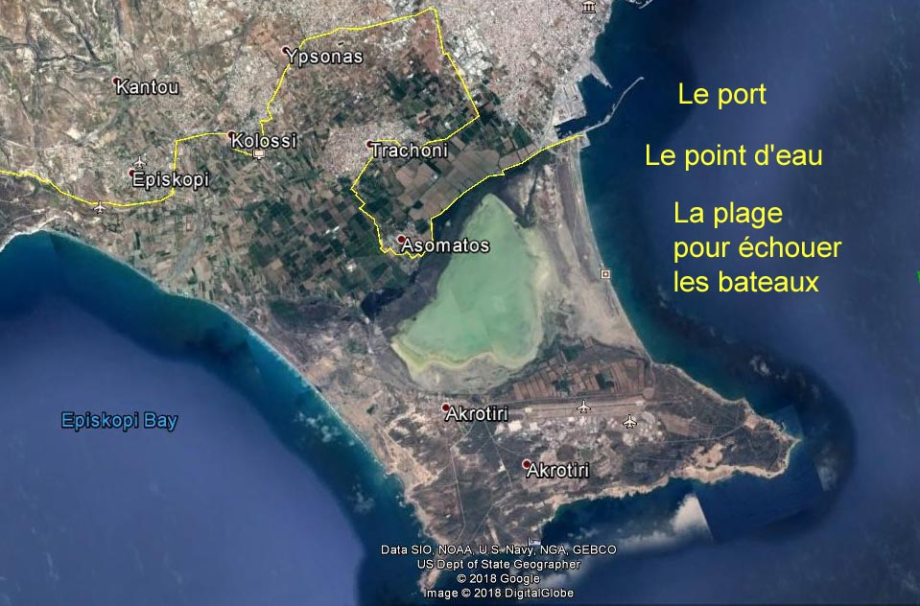
But we must assume an alteration of the text: Paphos instead of Pharos. Is this implausible in almost 3000 years of transmission?
And Pharos?
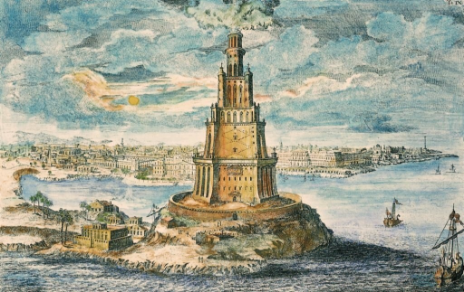
Destroyed for a long time, here is an artist's representation of what gave its name to all the lighthouses of the world: a rocky islet a few kilometers from Alexandria; not far enough, no port, no beach, no aiguade, in short not in accordance with the narrative
The journey from Scheria in Phaeacia (Corfu) to Ithaca
The ship of Alkinoos, king of Phaeacia, brings Odysseus back to Ithaca in one night of navigation. That is to say that he travels 90 miles in about ten hours: Ulysses has time, after sunset, to drink a last cup before boarding, to wake up before dawn, at the rise of Venus. (see pages 725 and 726 of the Pléiade edition)
![]()
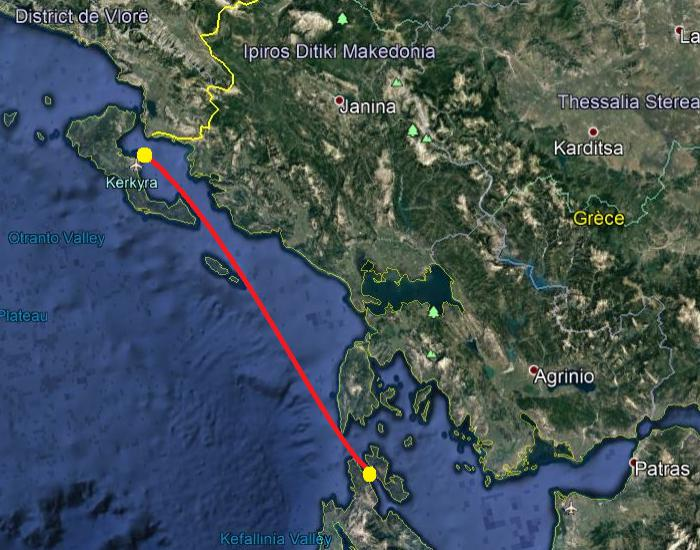
Here again, the speed of nine knots is confirmed
Other notes
The story of the Odyssey is rich in allusions to the gods and their attributes
These are possibly indications of direction to take.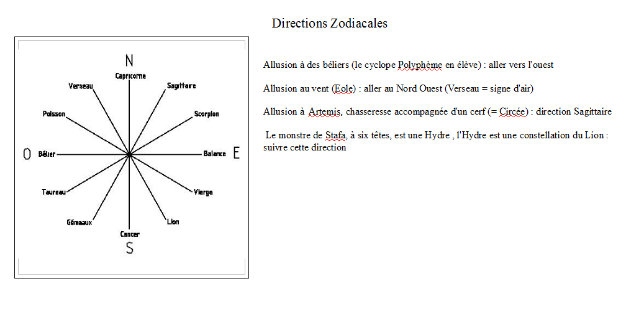 Similarly, the main winds are named:
Similarly, the main winds are named:
Notos: wind from the south
Similarly, the main winds are named:
Notos: wind from the south
Boreas: wind from the north
Zephyr: wind from the west
Euros: wind from the East
(See Wikipedia)
These names indicate the direction taken: the Greek ships, sailing, sail downwind. The narrative was very well able to cross the different linguistic ways, telling the same story, which serves as an immutable framework.
(in english) The Odyssey according to Gilbert Pillot
The Odyssey according to Gilbert Pillot
With these remarks, I took the trouble (and the pleasure...) to follow the route proposed by G. Pillot, with the help of the internet and especially Google Earth. The result is striking, the descriptions of the Odyssey crying out for realism in front of the proposed sites.
Everyone agrees that the composition of the Odyssey is disparate, from several sources and different eras. Of course for the form, but for the substance?
In fact, I am surprised that in this context it may be possible to find a coincidence with existing landscapes. It is remarkable that taking into account the speed of nine knots does not leave out any passage of the text. And we find on arrival landscapes corresponding to the descriptions of the Odyssey.
Let's resume the journey
2nd stage: a nine-day storm
At nine knots, one travels 216 x 9 miles equals 1944 miles. Starting from Cape Malée, we arrive on a continent, in Morocco, potentially in El Ouatia, shortly after the Wadi Draa, in a country growing dates – the lotos? - And Kat?

The question that comes to mind is: why go south out of Gibraltar?
The answer must be that of a true sailor: the southward inflection of navigation at the exit of Gibraltar, is due to the presence of a North current, the Canary current.
We will see in the rest of the story that the goal probably sought is the island of Eole (Madeira) The inflection towards the south of this path could be a warning of navigators which will have to take into account the North current at the exit of the Pillars of Hercules.
![]()
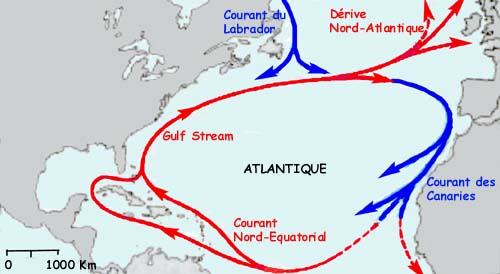
To return to the island of Eole, the route is punctuated by islands, and it is this path that Ulysses will take:
Reminder of the story of the Odyssey. :
Leaving the land of the Lotophagi, they arrive in the "land of round eyes" (The Cyclops).
In front of this island, a "Small Island": excellent land, forests, watered meadows, soft, suitable for vines and wheat. This island is populated only by goats.
Odysseus, leaving his troop there, goes to the main island with some warriors, to visit "a high cave", lair of a monster with one eye: Polyphemus.
The sea is wide open in front of Cape Juby.
But islands are nearby: Fuerteventura and Lanzarotte
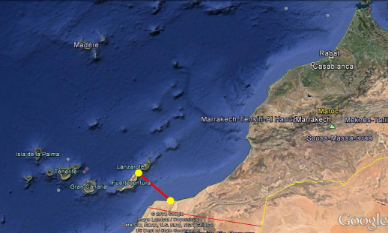
Here is an aerial photo of Lanzarote. It is tempting to call it the land of round eyes, the Cyclopia!
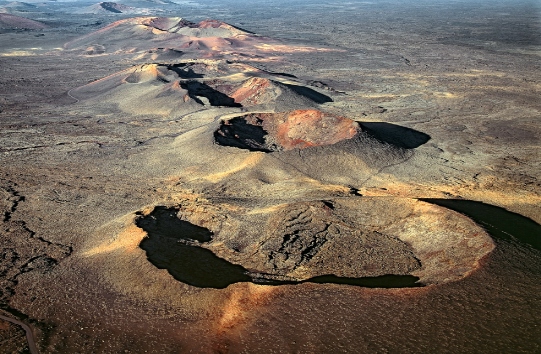
And in front of Lanzarote, as Ulysses describes it, a small island with a vast beach to run boats aground. It is difficult to access: shoals at the entrance of the bay are visible on the aerial view.
In the story of Ulysses. : "This island has in its port, holds so convenient that, without ashore the ships, they leave the ships. [....] That's where we come in: a god was driving us. »
(This mention "a god piloted us" is used in the Odyssey whenever there is a difficulty to fear: a valuable indication for navigation.)
The beach is still called today "la playa de la caleta", the beach of the hold.
(A "hold," in marine terms, is a gentle slope that allows boats to be launched.)
In addition, the island is wet and fertile, as in the description of Ulysses.
This is the island of Lobos
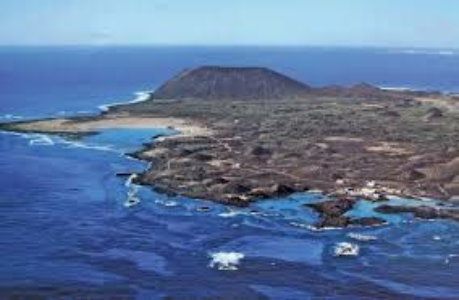
The descriptions of the Odyssey fit perfectly with these landscapes.
The quarrels with Polyphemus the volcano.
In the narrative, this interlude appears, which has the advantage of sustaining the dramatic interest and showing the malice of Ulysses. It is also an opportunity to justify one's misfortunes because of the resentment of the scorned Gods.
This episode has greatly inspired artists of all eras
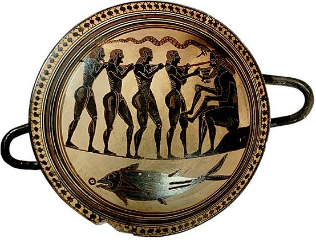
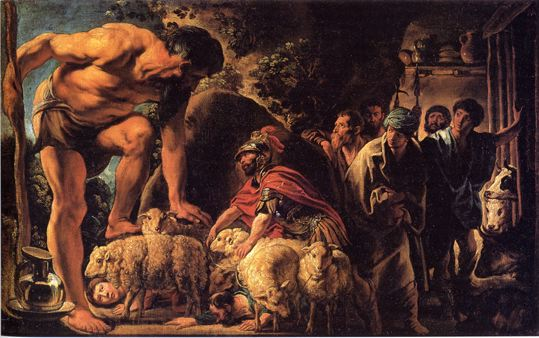
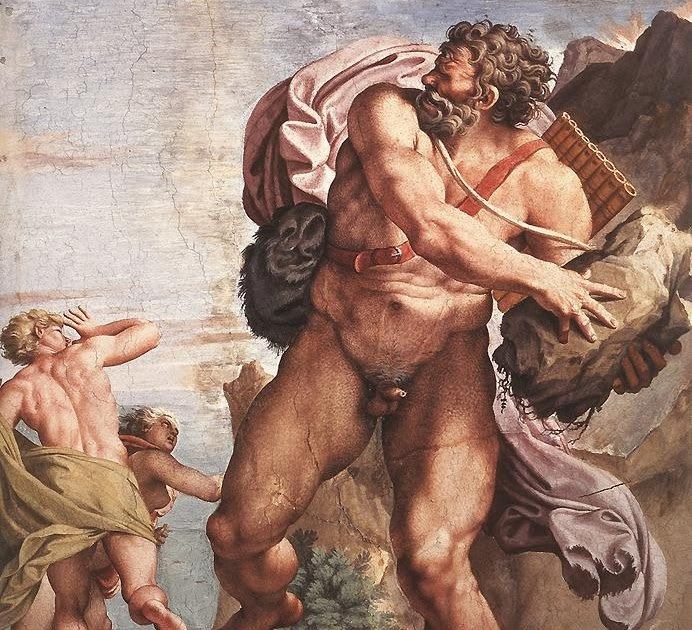
![]()
![]()
The torments inflicted on Polyphemus, son of Poseidon, offend the latter, who will pursue Odysseus with his vindictiveness, and cause him trouble; Poseidon is called the ground shaker and he is the god of the sea. : the Greeks thus made the connection between volcanoes and earthquakes.
After getting rid of Polyphemus, they leave again to reach the island of Eole: an island that floats, says the text, with bronze walls, a polished rock that points to the sky.
It is the portrait of Madeira, an island surrounded by currents, which can give the impression that it moves, therefore that it floats.
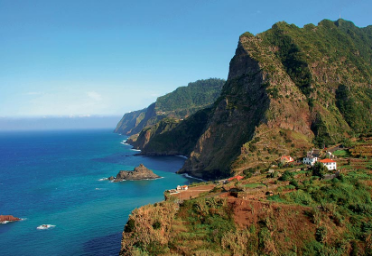
The crossing is not specified in its duration, but it follows the direction evoked by Aeolus, god of the winds (Eole = north-west direction)
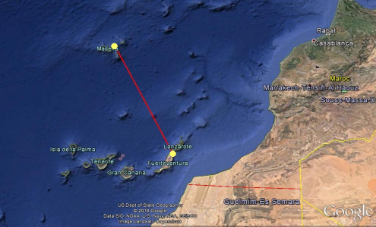
Odysseus and his companions well received by the God of the winds, who offers Odysseus a bag containing the contrary winds.
When they leave, after a month's stay, they intend to return to Ithaca. The wind that takes them is "the breath of a Zephir", west wind. So they go east.
The journey lasts nine days, then the companions of Odysseus open the otter containing the winds,
and a new storm brings them back to the island of Eole.
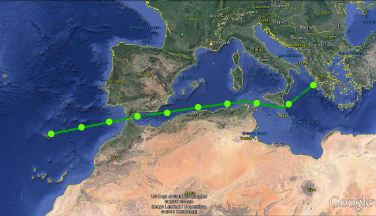
Again, the story is consistent with the speed chosen: the route Eole – Ithaca is 1896 miles, or 8.8 days at 9 knots
It is this round trip that shows that the meaning of this maritime relationship hidden in the Odyssey is to go first to the island of Eole (Madeira).
The story insists: after the involuntary detour due to the current, this is where we must arrive for the rest of the trip.
And why Madeira? Probably because this island is at the latitude of the entrance to the Mediterranean; so easy to find and find along the parallel using the tracking of the height of the Sun.at noon, the highest point of the Sun in the day.
This height is easy to control with rustic means: Jacob's stick or even just the outstretched hand.

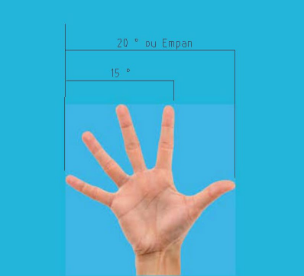
It is easy to see that 15° (angular distance between the little finger and the index finger) corresponds to the movement of the sun for 1 hour.
On their return, Eole considers that they are cursed by the Gods, and no longer wants to host them.
So they leave the island of Aeolus, to sail six days and six nights.
On the seventh day they arrive in the Lestrigon country.
In this country, the nights are short: the shepherd who leaves with his flocks greets another shepherd who returns.
The days are long: a brave man could earn double salary.
We must therefore look north for this point of arrival.
Let's keep the speed of 9 knots; a sailing of six days and six nights at 9 knots it makes a journey of 1296 miles (we arrive in Ireland) The seventh day arrives at the port (+88 miles for Killybegs).
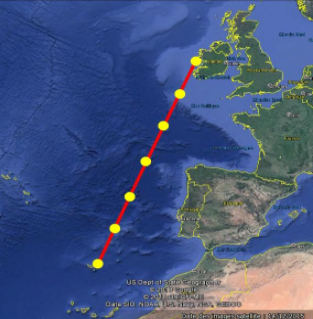
The port, "well known to sailors", is encased between two cliffs and very elongated.
The Lestrigons are in a bad mood and throw stones at boats.
The fleet is destroyed, only Odysseus' ship escapes.
Several sites may correspond to the description in this place of the coasts of Ireland
The Leenaun website
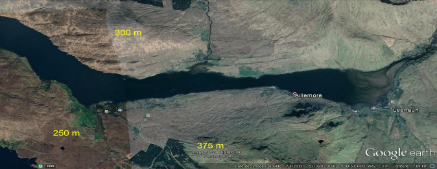
"A valley encased between two mountains". In the account of the Odyssey, the port is called Lamos. Sound to be compared to Leenaun?
Or in Mayo County

"A double cliff, steep and without cuts, stands all around"..
.Or rather Killibegs, still today an important fishing port.
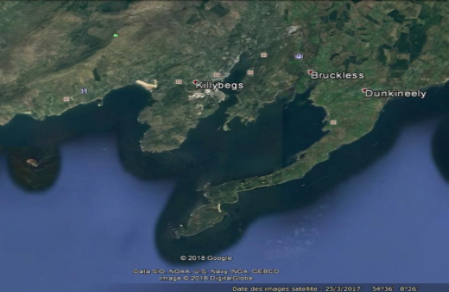
"Two elongated capes, which are opposite the front of the entrance, protect the mouth"
The Lestrigon country would therefore be the north of Ireland: Here is a country where, in summer, at this latitude, the days are long and the nights are short.
There is a site corresponding to the description made by the Odyssey.
And at a distance of six full days of sailing from the island of Eole (with our speculations already confirmed on the speed of the ships of 216 miles per 24 hours)
The island of Circe
In Greek mythology, Circe is a fearsome witch.
In the story of the Odyssey, she lives surrounded by animals, which makes her assimilate to Artemis the huntress. The encounter with a ten-horned deer is probably an allusion of this order. Is this also an indication of direction?
Ulysses and his remaining companions, leaving the other destroyed boats there, reach the island of Aiaié, home of Circe.
There, from the summit near the anchorage, we see a low plain surrounded by sea on all sides.
Travel to the island of Circe
G. Pillot imagined her as Bara, and searched unsuccessfully for possible traces.
It could rather be Tiree (Hebrides), in the direction suggested by the allusion to Artemis with the encounter with a deer. (Northeastbound)
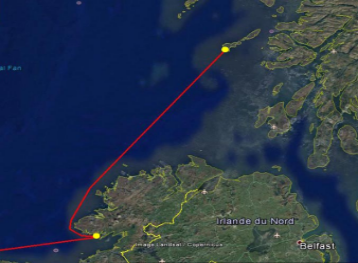
This island is part of Scotland:
A view of Tiree Island
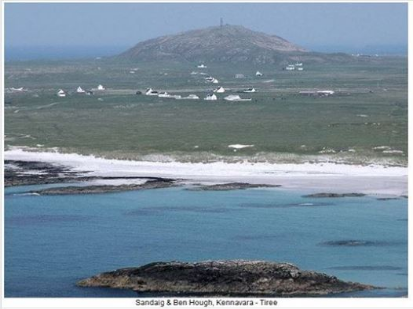
It is very close to the description: a flat island, and a promontory that allows you to see in the distance. But the one described by Ulysses was wooded. However, local archaeologists in Tiree believe that this was indeed the case in those remote times.
The beach of Balephuil which is the first that comes from the southwest is located between two heights: Kennavara (fifty meters above sea level) and Ben hynish (130 meters), which prevents you from seeing west and east ("neither the point of the noroit nor that of the dawn") from the beach (page 685). Ulysses complains! (Kennavara would be "the cape" and Ben hynish "the lookout" - where a radar, "the golf ball, is currently installed")
An additional reason: when describing the return trip, Circe indicates the island of the Sirens as a landmark, but not Tyree who would nevertheless be on the way from Bara.
And another curious clue: recent excavations on Tyree have highlighted a Bronze Age site, at a place called "Circeabol"!
Circe
Circe the witch transforms part of the crew into swine by giving them a drug (the ancestor of Whiskey?)
Ulysses goes to see Circe to retrieve his crew. She tries to drug him in turn, but Hermes has given the antidote to Ulysses.
Circe and half the crew
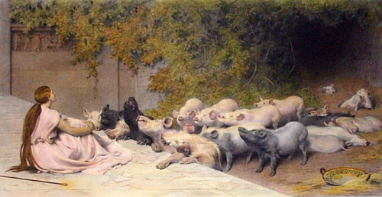
Circe hands Ulysses a drug, but Hermes pours the antidote
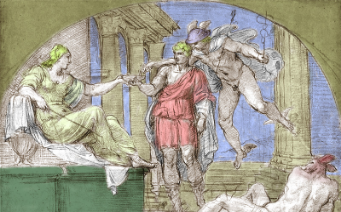
The charms of Circe

The underworld, in the land of the Cimmerians
After winter, spring returned, Circe told Odysseus to make a trip to the Underworld, to consult the soothsayer Tiresias who was there.
The journey begins with Boreas, the north wind (thus to the south), and continues as long as the day lasts until the confluence of several rivers of the underworld (the Acheron and the Pyriphlegethon, the Styx and the Cocytus). It is the land of the Kimmerians "covered with clouds and mists"... "Located in Noroi" (North West)
Ulysses meets many disappeared there.
Journey to hell
When one comes from Tiree (90 miles, or 10 hours at 9 knots), all the indications of the text agree: distance, direction taken, entry into a river, or in what one can take for such. A country covered in clouds and mists: Northern Ireland fits the description.
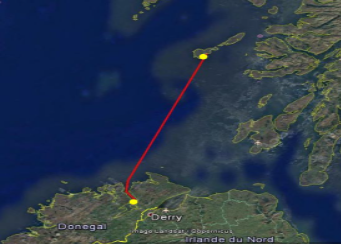
"goes to the places where the two rivers meet... »
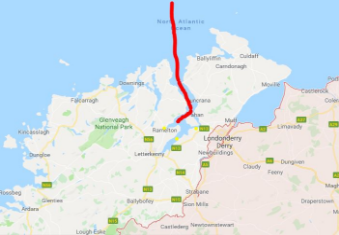
I think that the inlets of the abers can easily be mistaken for rivers, especially with a receding tide.
Returning from the Underworld to Circe, Ulysses considers the return journey.
Circe warns him against the Mermaids, birds with charming voices.
Supposed route
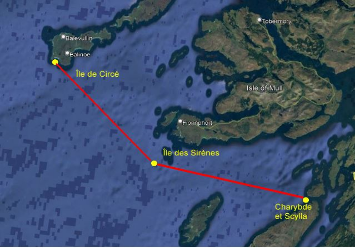
Ancient mermaids
Could the island of mermaids be an island laden with birds, Easily spotted from the sea?
And the "bleached bones" of guano? With the sui generis smell?
Ancient mermaids were birds
with charming voices.
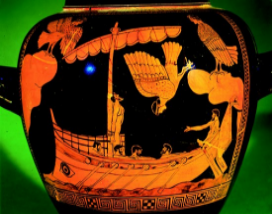
In the Middle Ages
Then they became fish-women
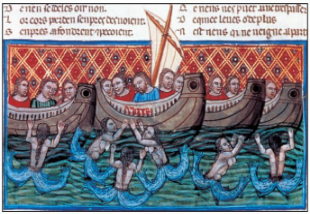
More recently
Then charming women
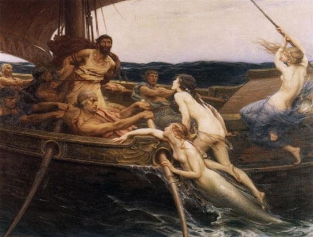
It is not the ears that
should have been plugged.....
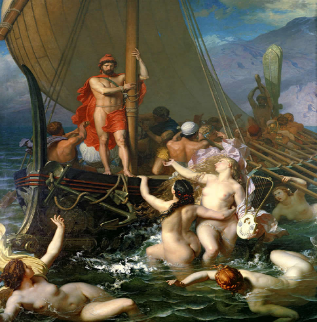
Then Back to navigation !
Circe described two routes to Odysseus:
1/ The Stones of the Pinnacle, exposed to the ocean. Only the Argo was able to pass these pitfalls.
2/ The two pitfalls of Charybdis (which swallows black water...) and Scylla (which shelters a monster)
Charybdis and Scylla
In the supposed direction, the route passes between the island of Scarpa, with its steep coast, and the north of the island of Jura with the lower coast: this corresponds to the description of the Odyssey.

« ... We see the divine Charybdis engulfing the black wave: she engulfs and vomits three times every day.... »
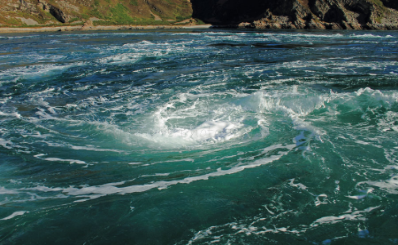
This photo is the reality of the Corryvreckan Strait.
This table is the tides in summer at this strait, visualized by a navigation software: there are two high tides and one low tide (or two low tides and one high) in a day (the days are long at these latitudes)

And it is true, as Circe specifies, that one is safer along Scarba -Skylla. (Oh, how similar these names are)
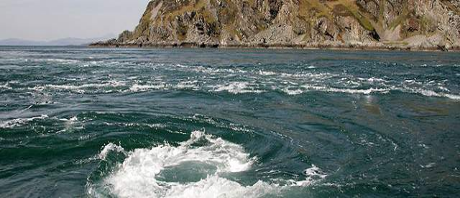
This strait leads to the island of Jura, where three aligned peaks (the three paps) strongly suggests the name of island "with three points" (Trinacrie).
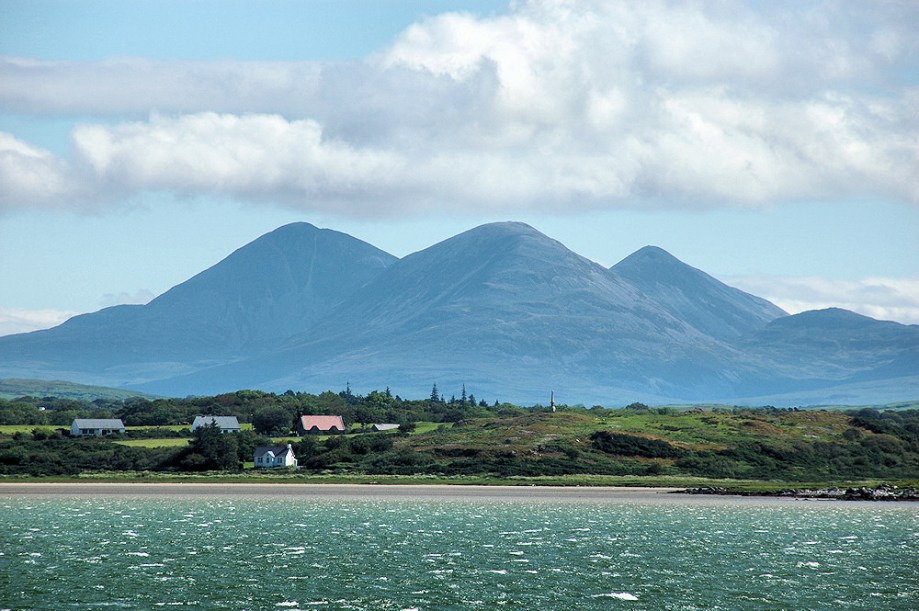
Precisely, this is what the Odyssey tells us:
Tiresias : "as soon as you escape the purple sea, your solid ship will put you on the shores of the island of Trident" (or Trinacria, or island of the Sun, in reference to Apollo).
There are herds of cows and sheep, which must not be touched (They belong to the Gods).
The descriptions of the Odyssey have been translated into images by many artists... with cows whose horns are lyre-shaped, in reference to the lyre of Apollo.
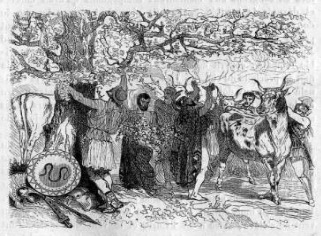
And what can we find on the island of Jura? Scottish cows...
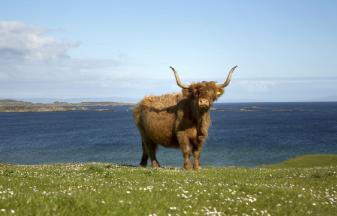
The boat is blocked by the south (Notos) or east (Euros) winds, which prevent it from taking to the sea.
The companions of Ulysses, driven by hunger, kill an ox of Apollo.
The Gods are angry and punish the offenders: the ship is shipwrecked.

It is clear that the inlet along the island of Jura is oriented North East / South West, and that potential shelters are likely to be blocked by the south and east winds.
Struck down by Zeus for having killed the oxen of Apollo, and now without companions, Odysseus passes the pitfalls of Charybdis and Scylla, and drifts for nine days, clinging to the wreck of the boat. He arrives on an "ocean island": the land of Calypso.
Problem: we had the scale of the speeds of movement of the boats swept away by the storm, or in navigation: about nine knots. On the contrary, it is a drift, hanging on a wreck.
But, rereading the text of the Odyssey, we find a strangely similar passage, where a comparable adventure happens to Ulysses: nine days of drift on a wreck, but this time we can determine the points of departure and arrival.This is happening in the Mediterranean.
Various considerations (see Gilbert Pillot's book) conclude a drift of 1000 km, in a north-west direction (heading 330). This, shown on the map, at the exit of the Corriewreckan Strait, leads us straight or almost to the south coast of Iceland.
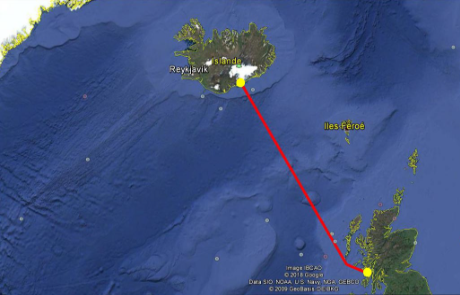
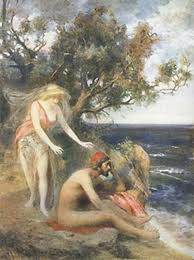
Ulysses has only a cap on his head.
He describes an astonishing, fertile and green country: Iceland remains likely.
He will be held back by Calypso for more than a year, but the Gods send Hermes to tell Calypso to let him go.
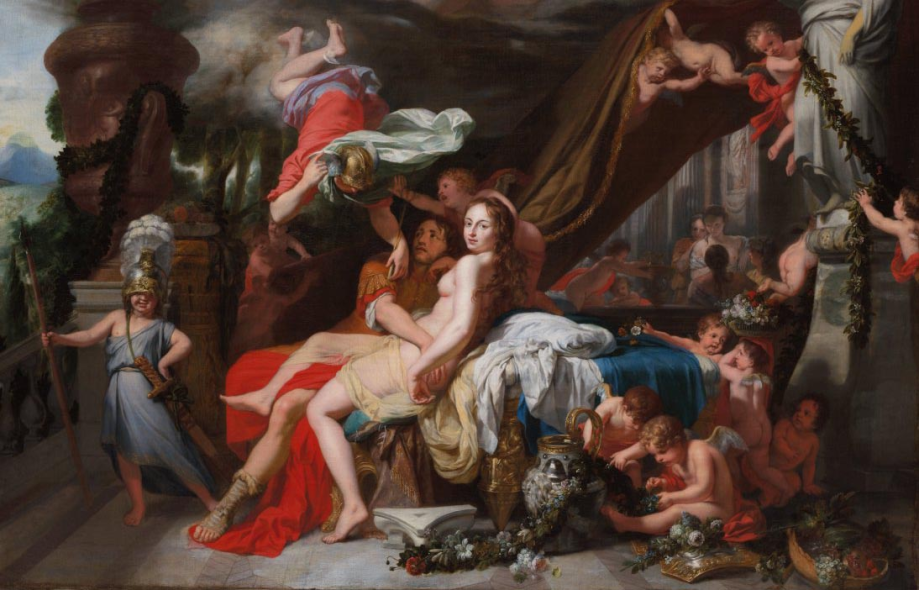
(When Hermes leaves Olympus to go to Calypso, he passes over Pieria.
Pieria is north of Mount Olympus, residence of the Gods.
The direction to reach Iceland passes through there, unlike the way to Gibraltar, Bérard's hypothesis.)
Aided by Calypso, Ulysses of a thousand tricks builds a boat to return to Ithaca
The trip lasts seventeen days!
The departure from Calypso's begins towards the south: "He looked at the Pleiades and the Bouvier"
These constellations are located in the South...
Then goes east: "we must keep the Big Dipper on the left"
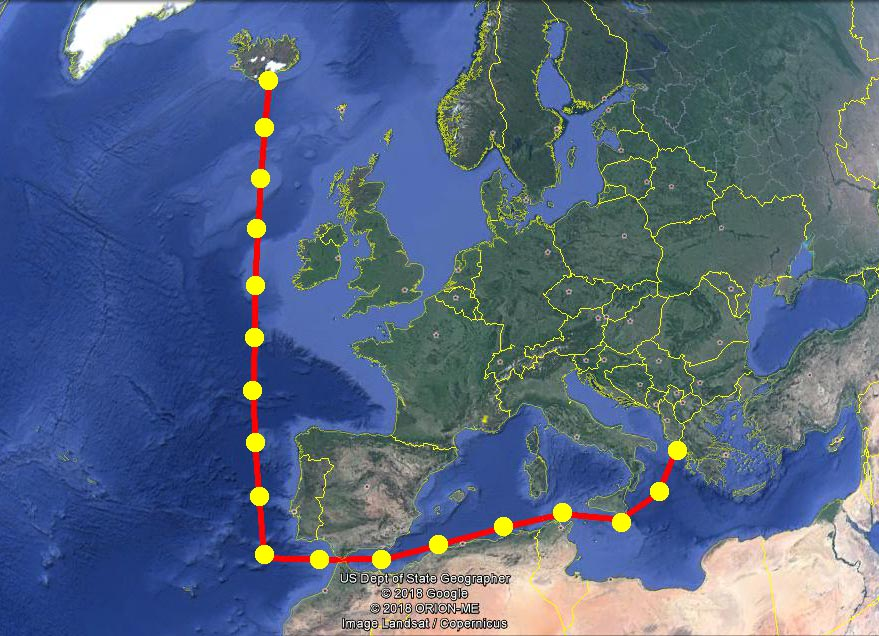
The hypothesis of nine knots of speed still holds!
And the other itinerary evoked by Circe?
"...The Stones of the Pinnacle, exposed to the ocean. Only the Argo was able to pass these pitfalls."
From the island of the Sirens, the road "exposed to the Ocean" is well in front of the Atlantic Ocean, where the disturbances from the West come from, with a leeward coast full of pitfalls, which sailors hate, especially on a boat likely to drift.
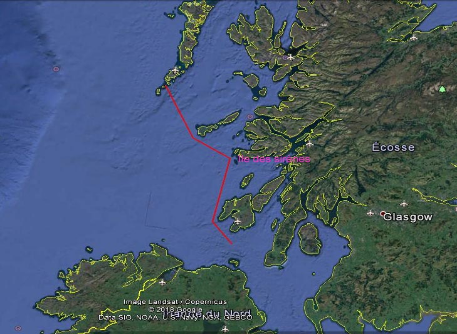
These roads seem to meet perhaps to Wales, and its tin mines. But the rest of the story was lost.
What "coincidences" that these correspondences of the sites with the text, with directions indicated by the bearing winds, and road times that follow the hypothesis of the nine knots!!!
But I don't think it's possible to find "concrete evidence" of these "coincidences." For the reason that the story of the Odyssey would be, according to G. PILLOT, only the pretext for the oral conservation of a maritime trade route, which moreover could very well have been incorporated by this hypothetical Homer well after the evocations of the peregrinations of Ulysses.
. Because this relationship draws in a logical (and marine) way a route to fetch gold from Ireland and tin from Wales.
The absence of evidence will keep this interpretation hypothetical.
Except perhaps with the tomb of Elpenor, the sailor who died in Circe's manor and met during the expedition to the underworld, which is said in the Odyssey was erected on the nearby cape: Should careful excavations be undertaken to find an urn containing Elpenor's ashes, and his burnt weapons? There is a pile of stones on Cape Kennavara that could be the tumulus "at the highest point of the cape?"
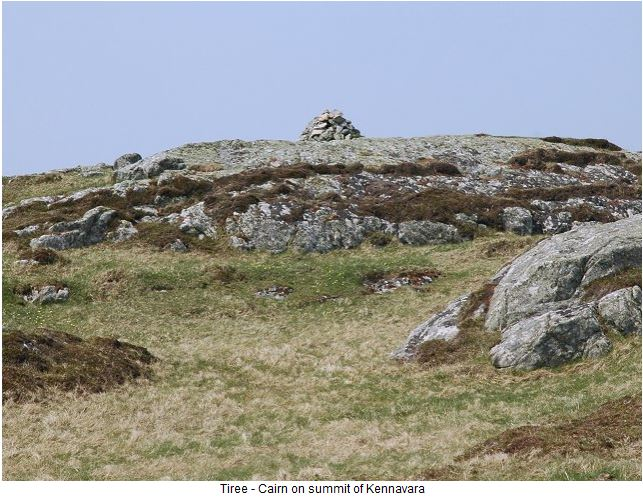
The fact remains that these "coincidences" leading to a coherence of Ulysses' relationship raise questions, and in my opinion deserve to be considered and studied, and not rejected in the name of poetry.
